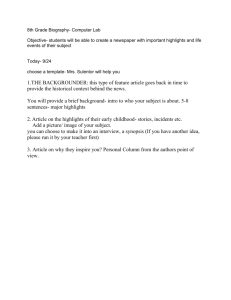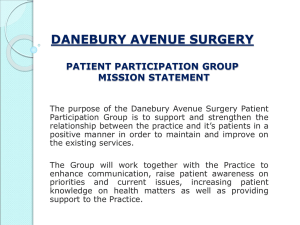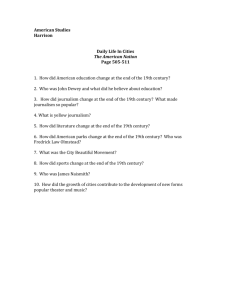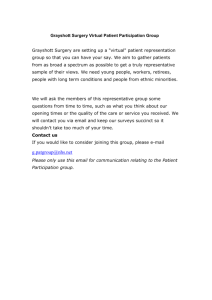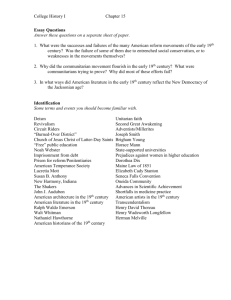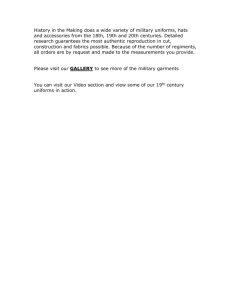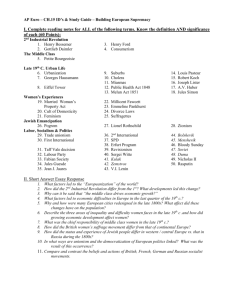History of Medicine
advertisement
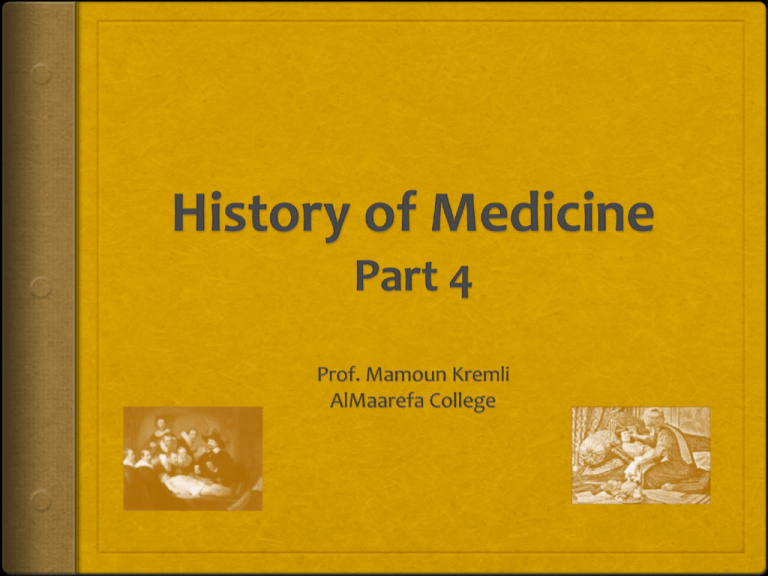
Outline Middle ages – in Europe Renaissance – in Europe Modern medicine Time-line 1543 C.E. The first scientific textbook on human anatomy is published by Andreas Vesalius, physician and professor of medicine at the University of Padua in Italy. Vesalius based his work on dissection of human cadavers. 1628 C.E. William Harvey shows (for the first time) that the heart pumps blood through the arteries to all parts of the body, and that blood returns to the heart through the veins. 1600s C.E. Antony Leeuwenhoek uses a microscope and discovers red blood cells, bacteria, and protozoa Time-line 1796 C.E. The smallpox vaccine is developed by Edward Jenner, initiating the science of immunology. 1800s C.E. Florence Nightingale, through her work during the Crimean War, establishes the foundation of modern nursing. Circa 1840 C.E. Americans Crawford Long and William Morton independently discover that ether gas can be used as a general anesthetic, allowing doctors to perform operations never possible before. Time-line 1865 C.E. Joseph Lister introduces antiseptic methods to surgery during a time when close to half of all surgical patients die of postoperative infection. 1898 C.E. Pierre and Marie Curie discover radium, which becomes a powerful weapon against cancer. 1928 C.E. Sir Alexander Fleming discovers the germ-killing power of a mold called penicillium, later isolated as penicillin, the first antibiotic. Time-line 1950s C.E. Jonas Salk develops the first successful polio vaccine. 1954 C.E. American surgeons transplant a kidney, the first successful organ transplant. 1970s C.E. The World Health Organization announces worldwide eradication of smallpox Middle Ages (AD 800–1400) Disease Leprosy, Syphilis, Plague, Typhus Privation – Pillaging, looting and sacking followed by famine, starvation and disease leading to repeated mortality crises of 1/3rd of population Bubonic Plague killed 75% of the population in Europe and Asia Response Quarantine introduced in Venice in 1403 Middle Ages (AD 800–1400) Influence of Arabic medicine, translations and new books Some studied abroad (scholarships) in Andalusia There was renewed interest in medical practices of the Greek and Romans Colleges opened Middle Ages (AD 800–1400) Medical Care: Self-help - prayer, pilgrimage, charms, herbs, magic stones, holy water Local noblemen knowledge of disease/therapy obtained by formal education Professional healers physician-clerics who had studied abroad Barber-surgeons Middle Ages (AD 800–1400) Arab physicians used chemistry to advance pharmacology Arabs begin requiring physicians to pass examinations and obtain licenses Renaissance (AD 1350–1650) Dissection of the body led to an increased understanding of anatomy and physiology Invention of the printing press allowed medical knowledge to be shared. First anatomy book by Andreas Vesalius, was published Renaissance (AD 1350–1650) Healers: Quacks and Mountebanks Apothecaries Surgeons Physicians Renaissance (AD 1350–1650) Quacks and Mountebanks Set up in town for a few days hen moved on Cheap remedies available to the masses Popular with the people Attempts by corporations of physicians and surgeons to prohibit them failed Magistrates were aware of their popularity Renaissance (AD 1350–1650) Apothecaries Evolved from grocers and spicers to supply physicians' needs to compound prescriptions Physicians were prevented, by their code, from dispensing medications Apothecaries were prevented from charging for giving advice although many patients sought their opinion Became rich as a result of physicians' bizarre prescribing practices Renaissance (AD 1350-1650) Surgeons Decree of Pope Innocent III in 1163 discouraged monks from performing surgery Barbers took over surgical work of monks Familiarity with use and care of sharp, rustprone instruments Incorporated with surgeons as a craft Skills acquired by apprenticeship Renaissance (AD 1350–1650) Surgeons Wound healing Setting of fractures Amputations, embalming, removal of teeth, treatment of skin disease, and blood letting Training by apprenticeship Converted to college/university degree in 1800's Renaissance (AD 1350–1650) Physicians Most prestigious of healers Distinguished by education abroad and large fees Because of expense of training, came from rich families Large towns with reasonable number of rich potential patients Management deliberately elaborate, including complicated mostly useless prescriptions 16th, 17th, and 18th Centuries Invention of the microscope in 1666 allowed doctors to see disease-causing organisms Apothecaries led to development of pharmacies 17th Century Circulation 1628: Harvey Advances in physiology The microscope 1676 (Antonie van Leeuwenhoek) Pathologic anatomy (1682 – 1771) Air was vital to life (1685) Andreas Vesalius Prior to Vesalius learning anatomy consisted of reading the texts of ancient Greek physicians First to use hands on dissections to teach about anatomy Instead of digging up bodies in the dark he started to be allowed to do dissections on executed criminals Produced fantastic diagrams based on human experimentation (Galen’s drawings were from apes) De Humani Corporis Fabrica (On the fabric of the human body) De Humani Corporis Fabrica (On the fabric of the human body) De Humani Corporis Fabrica (On the fabric of the human body) Ambroise Pare Pioneered many surgical treatments and specialized in the treatment of wounds Used a mixture including turpentine to heal wounds (cleaned the wound) Used ligatures of arteries to reduce blood flow and slow bleeding Ambroise Pare Used cauterization techniques prior to amputation Hypothesized that phantom pain after amputation arose in the brain Revived the practice of podalic versiori to deliver babies not coming out safely Bezoar Stone Experiment The Bezoar stone was reputed to be able to cure the effects of any poison Pare’s cook was caught steeling silverware The cook agreed to be poisoned to determine if the stone in fact worked The cook died days later proving that the Bezoar stone had no miraculous healing properties William Harvey Described the process of blood being pumped around the body by the heart Discovered how valves in the veins work Postulated that the circulatory system was closed and that the heart re-circulated throughout the body Clashed with Galen’s concept that blood was created in the liver and that there were two types of blood William Harvey Theorized that there are two separate loops of the circulatory system, one to the lungs and the other to the rest of the body Carried out dissections showing that embryos do not possess characteristics of adults 16th, 17th, and 18th Centuries Edward Jenner developed the first vaccination to prevent the spread of smallpox in 1796 18th Century Surgery Louis XIV: Fistula Separated from barbers 1745 Child birth: male obstetricians Industrial revolution Urbanization: overcrowding Industrial hygiene and disease of workers (19th Century) Modern Medicine 1840: first clear statement of living agents of disease 1842-46: Ether as an anesthetic agent 1844: nitrous oxide: pain control 1847: Chloroform anesthetic (19th Century) Modern Medicine 1868: Thermometry Hypodermic syringe 1886: The ampoule With all these advances, medical services were not available to the average individual 19th Century Formal training for nurses led by Florence Nightingale began Infection control methods were developed once microorganisms were associated with disease (19th Century) Medical Education 1871 Harvard Raised entrance requirements Lengthened to 3 years Better facilities for lab and clinical instruction (19th Century) Medical Education 1893 John Hopkins Required Bachelor's Degree Student serve as clerks Graduates spent several years as interns and residents Research become dominating feature in all department (19th Century) Medical Education 1909 – 1911 Flexner: report Closed many schools Raised standards Revised curricula Only the elite (19th Century) Medical Research Outstanding scientist in 19th Century Liebig at Giessen 1824 Virchow in berlin 1856 Pasteur in Paris 1888 Koch in Berlin 1905 (19th Century) Medical Research Huge sums to foster research Quest of new knowledge 1850 US $ 74 Million 1955 US $ 261 Million 1974 US $ 4 Billion (19th Century) Medical Research Scientific Journals 1800 100 1900 10 000 2000 1000 000 20th Century Gained an increased knowledge about the role of blood in the body: ABO blood groups discovered Determined how white blood cells protect against disease 20th Century New medicines were developed: Insulin to treat diabetes Antibiotics to fight infections caused by bacteria Vaccines to prevent people from getting diseases caused by viruses 20th Century New machines were developed: Kidney dialysis machine Heart lung machine Computerized axial tomography (CAT) scan 20th Century Surgical and diagnostic techniques were developed to cure once fatal conditions: Organ transplants Limbs reattached Test tube babies Amniocentesis Implanted first artificial heart 20th Century Ultrasound CT scan Bone scan MRI Operative navigation systems 3-D printing 20th Century Health care plans developed to help pay the cost of health care Medicare and Medicaid marked the entry of the federal government into the health care arena HMO’s provided an alternative to private insurance Hospice was organized History of medicine highlights Plague pandemic started in 1332 in India, spread through China and Russia to Constantinople and Italy In the middle of 14th c.- whole Asia, Europe and north Africa …wasteland, extinct cities, corps lying around, with no one to bury them History of medicine highlights “black death" most prominent in Dalmatia (Split, Zadar, Dubrovnik) In Dubrovnik in 1377 – first quarantine in the world – 40 days of isolation and observation prior to unloading the cargo and people Hadith shareef: History of medicine highlights Girolamo Fracastoro – theory about invisible germs that spread and cause diseases Through direct contact, via objects, ability to spread far from the source Refutes Galen’s "miasm theory” (poisonous air and fumes) Girolamo Fracastoro "De contagione et contagiosis morbis“ in 1543 – claims that germs multiply, are poisonous, could be destroyed by fire Recommends regular body hygene, clean environment, water and food sanitation, disinfection History of medicine highlights Microscope discovery Antony van Leeuwenhoek in 1670 Analyzed blood, saliva, bones, muscles, human eye lens, ect. Achieved magnification up to 40-160 times, later up to 270 times History of medicine highlights In 18th c. doctor from Slovenia Marko Anton Plenčić supports the theory about small living creatures which cause communicable diseases He hypothesized that different creature causes different, specific disease History of medicine highlights At the end of 18th c. British doctor Edward Jenner noticed that women who milk cows often get cow pox (much more benign than smallpox) and never get smallpox, as a consequence Edward Jenner After 20 years of observation – experiment on 8yrs old boy James Phipps Jenner took the pus from the hand of a women with cow pox and applied it to the boy – after 6 weeks the boy was exposed to smallpox – didn’t get smallpox Published a book about vaccination in 1798 (vacca=cow) History of medicine highlights Only in 19th century bacteria have been discovered Pollender discovered one of the largest bacteria - anthrax in the blood of dead animals History of medicine highlights Louis Pasteur – foundations for modern theory about causes of communicable diseases discovered yeasts introduced pasteurization for wine and milk Noticed how anthrax culture loses virulence – when applied to healthy animal it didn’t cause the disease Created vaccine to immnunize rams against anthrax In 1881. discovered streptococcus and staphylococcus bacteria Louis Pasteur In 1885 L. Pasteur introduced vaccination agains rabies Dried spinal cord from dogs died of rabies Pasteur applied for 9yrs old boy Joseph Meistera, who was bitten by a rabid dog – the boy was saved Countless lives were saved all over the world History of medicine highlights During 19th c. in England – great cholera epidemic John Snow – a doctor perticulary interested in this epidemics in 1854 creates hypothesis that cholera was transmitted via water History of medicine highlights 1882 Robert Koch discovered M. tuberculosis 1890 discovered tuberculin, first considered cure, later became diagnostic tool Tuberculosis was a pandemic at the end of 19th c. due to poor social and economic conditions History of medicine highlights At the end of 19th c. Koch and Pasteur formed new discipline – Microbiology History of medicine highlights Beginning of 20th c. – discovery of viruses 1908 - Karl Landsteiner - poliomyelitis virus 1912 - Wilhelm Grueter – herpes virus History of medicine highlights In 1907 Paul Erlich introduced chemotherapy (chemicals that selectively destroy microorganisms, without causing damage to the host) 1923 – systematic prophylactic BCG vaccine History of medicine highlights 1928 Alexander Fleming accidental finding that the presence of molds blocked coccus culture growth Penicillium notatum - penicillin History of medicine highlights Only from 1940s penicillin was applied during WWII against coccus bacteria, C. diphtheriae, anthrax, tetanus Over following years – discoveries of other antibiotics, most important was streptomycin (Selman A. Waksman – coined term antibiotic) Top achievements in medicine? http://science.discovery.com/convergence/10 0discoveries/big100/medicine.html http://www.healthfiend.com/weeklytop/top10-greatest-medical-discoveries-of-all-time/ Jon Queijo: Breakthrough!: How the 10 Greatest Discoveries in Medicine Saved Millions and Changed Our View of the World Chapter 1. The World’s First Physician: Hippocrates and the Discovery of Medicine Chapter 2. How Cholera Saved Civilization: The Discovery of Sanitation Chapter 3. Invisible Invaders: The Discovery of Germs and How They Cause Disease Chapter 4. For the Relief of Unbearable Pain: The Discovery of Anesthesia Chapter 5. I’m Looking Through You: The Discovery of X-Rays Chapter 6. The Scratch that Saved a Million Lives: The Discovery of Vaccines Chapter 7. From Ancient Molds to Modern Miracles: The Discovery of Antibiotics Chapter 8. Breaking God’s Code: The Discovery of Heredity, Genetics, and DNA Chapter 9. Medicines for the Mind: The Discovery of Drugs for Madness, Sadness, and Fear Chapter 10. A Return to Tradition: The Rediscovery of Alternative Medicine Landmark Advances Year Landmark Inventor C. 1280 Spectacles ? 1540 Artificial limb Ambrose Pare 1714 Mercury Thermometer Gabriel Fahrenheit 17715 Bifocal lenses Benjamin Franklin 1792 Ambulance Jean Dominique Larrey 1796 Vaccination Edward Jenner 1816 Stethoscope Theophile Laennec 1817 Dental Plate Antony Plantson Running Press Cyclopedia, Landmark Advances Year Landmark Inventor 1827 Endoscope Pierre Segalas 1846 Anesthetics William Morton 1851 Ophthalmoscope Hermann von Helmholtz 1853 Hypodermic syringe Alexander Wood 1865 Antiseptic Joseph Lister 18815 Rabies Vaccination Louis Pasteur 1867 Contact lenses Adolf Fick 1895 X-ray Wilhelm Rontgen Running Press Cyclopedia, Landmark Advances Year Landmark Inventor 1903 Electrocardiography William Einthoven 1928 Antibiotics Alexander Fleming 1957 Pacemaker Clarence W Lillehie and Earl Bakken 1967 Heart transplant Christiaan Bernard 1973 CAT scan Godfrey Hounsfield and Allan Cormack 1979 Ultrasound scan Ian Donald 1982 Artificial Heart Robert Jarvik Running Press Cyclopedia, http://www.kaahe.org/health/ar/class/173-أعالماألطباء-المسلمين-والعرب.html http://www.nytimes.com/interactive/2012/10/05/ health/digitaldoctor.html?ref=thedigitaldoctor&_r=0#/#time15 _375 http://en.wikipedia.org/wiki/Timeline_of_medici ne_and_medical_technology Detailed timeline from 2600 BC to 2013 AC http://www.historylearningsite.co.uk/history_of _medicine.htm Look for Arabic / Muslim Medicine Prehistoric Medicine Chinese Medicine Medicine in the Middle Ages Egyptian Medicine Greek Medicine Native American Medicine Old Indian Medicine Roman Medicine Eastern Medicine Nobel prize winners in Medicine Look for History of herbalism History of Epidemiology History of hospitals History of Nursing History of medicine History of Psychiatry (Medicine of the mind) Canada, USA, UK, Europe, History of nursing History of pathology History of pharmacy Thomas Clifford Allbutt History of medicine[134] Timeline of nursing history History of surgery Timeline of medicine and medical technology History of Virology Milestones in history of medicine History of Microbiology Major developments in medicine Men of Medicine Period Name Discovery – Famous for Hippocrates Father of Medicine Galen 850- Rhazes الرازي Ali Ben el-Abbas علي بن العباس Albucasis Zahrawi آبو القاسم الزهراوي 980-1037 Avicenna ابن سينا Ibn Nafis ابن النفيس AVENZOAR / Ibn-Zohr ابن زهر Averroës (Ibn Rushd) ابن رشد 1188 – 1248 Ibn al-Baitar ابن البيطار Men of Medicine Period Name Discovery – Famous for 1493-1541 Parcelsus 1514-1564 Andreas Versalius 1510-1590 Ambroise Pare 1578-1657 William Harvey 1632-1723 Antoni van Leeuwenhoek 1716-1794 James Lind 1749-1823 Edwaed Jenner 1778-1829 Sir Humphry Davy Nitrous Oxide anesthesia 1811-1870 Sir James Young Simpson Chloroform anesthesia 1819-1868 William Thomas Green Glass inhaler - Ether 1802-1887 JEAN boussingault Iodine cures goiter Scurvy cured by Vit C Men of Medicine Period Name Discovery – Famous for 1813-1858§ John Snow Father of public health 1858-1930 Christian Ejikman Beriberi cured by brown rice 1816 Rene - Theophile Hyacinthe The stethoscope Ignaz Phillipp Semmelweiss Childbed fever spread by doctors Joseph Lister Aseptic surgery Robert Koch Bacteria caused disease 1822-1895 Louis Pasteur Bacteriology / Vaccination / Pasteurization 1881-1955 Alexander Fleming Penicillin 1904-1950 Richard Drew Blood transfusion / banks 1922-2001 Christian Barnard First heart transplant 1967 1827-1912 Men of Medicine Period Name Discovery – Famous for James Watson / Francis Crick Discovered DNA William Kolf Artificial Kidney machine Wilheim Rontgen X-ray in 1895 Techniques & Procedures Abortion Anesthesia Acupuncture Angioplasty African traditional Medicine Animal/human transplants Alchemy Antibiotics Ambulance Antidepressants Amniocentesis Antimalarial drugs Amputation Artificial eye Amulets and talismans Aspirin Autopsy Ayurveda Techniques & Procedures BCG vaccine Burns – treatment skin graft Biopsy Cancer / anti-cancer Blood Groups and transfusion Chemotherapy Blood pressure Bloodletting Bone setters Breast implant Breathalyzer Chloroform Clinical trials Contact lens Corneal transplant Cortisone CT / CAT scan Cupping Techniques & Procedures Defibrillator Genetic testing Diet Genes and human genome Dissection Germs and germ theory DNA structure Gloves, gowns ECG Hearing aid EEG Heart-Lung Machine Electroconvulsive Therapy HeLa Cells Electrotherapy Herbal medicine Electron microscopy Hippocratic medicine Endoscope Hippocratic oath Homeopathy Techniques & Procedures Hormones Intravenous infusion Hospitals In-Vetro Fertilization (IVF) Hydrotherapy Informed consent Hygiene Inhalers Hygienic products inoculation Hypodermic syringe Insecticides Incubators Insulin Techniques & Procedures Intrauterine device IUD Liver transplant Iron lung (Respirators) Lung transplantMagic bullets Kampo (Japanese medicine) Massage Kidney dialysis Meat inspection Kidney transplant Mechanical ventilators Laser in medicine Medical education Leech tharapy Miasma theory Techniques & Procedures Microscope Oral contraceptive pill Military hospitals Ophthalmoscope MRI Orthopedic surgery Neurosurgery Osteopathy Nuremburg code and trials Pacemaker Nursing Palpation Ophthalmoscope Patients' records Techniques & Procedures PCR Pulse measurement Percussion and palpation Randomized controlled trials Plaster of Paris Penicillin PET scan Physiotherapy Pregnancy tests Radio-isotope scan Renal Dialysis Rhinoplasty Robotic surgery Sterilization Techniques & Procedures Speculum Tissue culture Stem cells Traditional medicine Stethoscope Trephination Surgical instruments Triage Surgery Ultrasound Thermometer Scurvy Thermal ablation Syphilis Techniques & Procedures Vaccination Yin and Yang Vivisection التجبير العربي War surgery الطب الشعبي Wet-nursing and milk banks wheelchair Wu Xing X-rays History of Diseases Allergy Brain surgery Alzheimer’s disease Carcinogens Appendectomy Cholera ARDS Cochlear implant Asthma Cataract Bladder stone Beriberi Cholera Botulism Diabetes History of Diseases Diphtheria Gout DVT Hearing aid Epilepsy Heart valve replacement Food poisoning Heart failure Gallstones Heat stroke Gangrene Hepatitis Goiter Hernia History of Diseases Herpes Malaria Hypertension MERS (Corona) Internal fixation of fractures Meningitis Jaundice Joint replacement Kyphosis Leprosy MRSA Open heart surgery Plague Pleurisy History of Diseases Poliomyelitis Thyroid disease Puerperal fever Tonsillectomy Rabies Trachoma Rickets Tuberculosis Surgery Thalidomide Swine flue (H1N1) Typhus Tetanus Urethral stones and strictures http://thequeenstable.blogspot.com/ Medical Students 140 yrs ago No one worried about admissions entrance requirements were lower than they are for a good high school student Instruction was superficial and brief The terms lasted only 16 weeks, and after the second term the M.D. was automatically given, regardless of a student’s academic performance Medical Milestones MEDICAL MILESTONES | BMJ | jANUARY 2007 | volume334 Medical Milestones MEDICAL MILESTONES | BMJ | jANUARY 2007 | volume334
